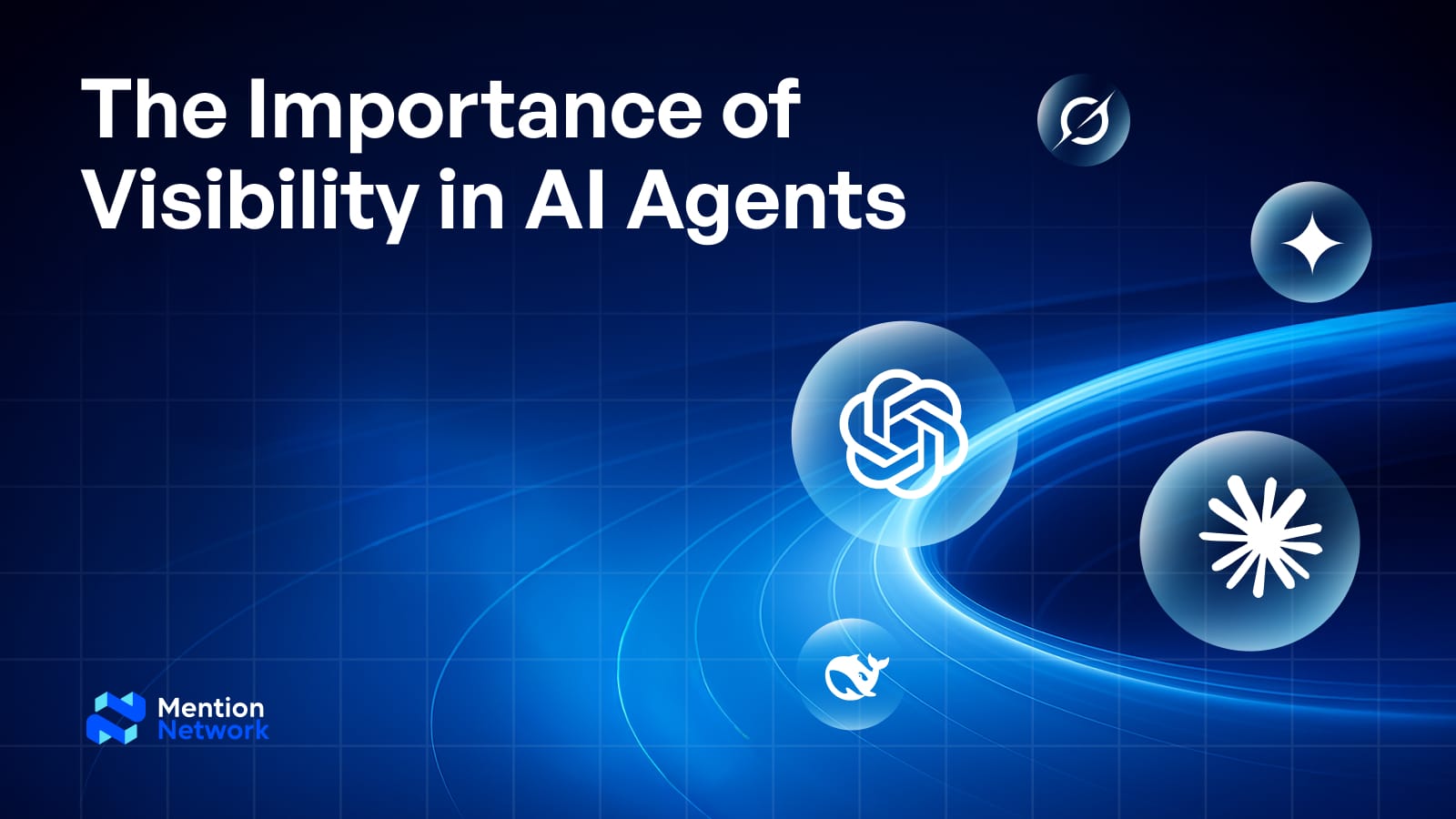The Importance of Visibility in AI Agents

The future of business isn't built on static applications, it's being constructed by autonomous, reasoning systems known as AI Agents. These agents, powered by sophisticated Large Language Models (LLMs), are increasingly taking on complex, multi-step tasks from managing supply chains and executing marketing campaigns to automating code deployment. They represent an enormous leap in efficiency and capability.
Yet, this power introduces an existential risk: the Invisible Challenge. As these agents operate autonomously, making thousands of internal decisions and navigating complex external APIs, they often become opaque black boxes. When an AI Agents fails, hallucinates, or makes a costly error, tracing the root cause understanding why the agent chose a specific path can be nearly impossible without a robust visibility framework.
For developers, founders, and investors, AI Agent Visibility is not a luxury, it is the non-negotiable security layer required for trust, auditing, and continuous improvement. Without comprehensive logging, monitoring, and tracing built into the agent's architecture, scaling autonomous systems is simply too high a risk.
The Invisible Challenge: Autonomous AI Agents inherently lack transparency, making debugging errors, auditing decisions, and ensuring compliance nearly impossible without explicit logging.
Why Comprehensive Logging Matters: Standard application logs are insufficient, agents require contextual, multi-step tracing that records the LLM prompts, tool usage, reasoning steps, and final outputs.
The Compound Effect of Visibility: Effective monitoring doesn't just fix errors, it provides the feedback loop necessary to continuously fine-tune the agent's behavior and improve its core decision-making logic.
Building Visibility into AI Agent Architecture: Visibility must be treated as a first-class concern, requiring dedicated components for telemetry, tracing, and secure storage of sensitive execution data.
Essential Tools for AI Agent Monitoring: Specialized observability platforms are required to handle the unique, unstructured data generated by LLM reasoning, moving beyond traditional APM solutions.
Key Features to Look for in AI Agent Monitoring Tools: Prioritize tools offering trace visualization, cost monitoring (token usage), and native support for major AI frameworks like LangChain andAutoGen.
The Invisible Challenge: Why AI Agents Are Inherently Opaque

Unlike traditional software, AI Agents involve probabilistic reasoning and dynamic decision-making that make standard debugging techniques ineffective, demanding purpose-built AI Agent Visibility solutions.
In conventional software development, if a database query fails, the stack trace immediately points to the line of code responsible. This is deterministic. AI Agents, however, operate in a state of probabilistic uncertainty. When an agent receives a prompt, the LLM generates an execution plan based on its internal weights, past context, and available tools (APIs). The outcome is not a simple function call, it is a reasoned choice.
Consider an autonomous marketing agent tasked with optimizing an ad campaign budget. If the budget suddenly spikes, the developer or auditor needs to know:
- What was the initial goal (prompt)?
- What tools did the agent decide to use (e.g., Google Ads API, financial ledger)?
- What was the agent's internal reasoning (the "thought" trace) that led to the budget change command?
- Was the final output (the API call) executed correctly?
Without a dedicated AI Agent Visibility layer capturing these four distinct steps, the final budget spike is simply a mystery. This lack of transparency undermines trust, security, and governance especially in highly regulated industries. The invisible challenge is the inherent difficulty of translating a probabilistic, natural language reasoning chain into a discrete, auditable transaction log.
- Why it matters: As agents handle higher-value tasks, the cost of a non-auditable error escalates from a bug to a catastrophic compliance failure or significant financial loss. Visibility is the only mitigation.
Why Comprehensive Logging Matters: Beyond the Stack Trace
Standard application logging is designed for synchronous, linear execution, AI Agents require contextual, multi-step tracing that captures the entire, often circular, decision-making path of the LLM.
The core data structure in traditional monitoring is the stack trace. The core data structure for AI Agent Visibility is the execution trace, which maps the agent's entire journey from prompt to completion, often involving multiple cycles of reasoning.
Comprehensive AI Agent Logging must capture several unique data points that are irrelevant in traditional software:
1. Prompt and Response Fidelity
The subtle phrasing of a user's prompt or the exact wording of an LLM's intermediate thought process can be the difference between success and failure. Visibility tools must log the raw input prompt, the LLM version used, temperature settings, and the verbatim LLM response (including any "thought" blocks) before the next action is taken. This is essential for reproducibility you can’t debug a hallucination if you can't recreate the exact cognitive state that caused it.
2. Tool Usage and Environment Context
Agents derive power from their ability to use external tools (functions, APIs). The log must record every tool invocation, including the specific arguments passed, the API response received, and, crucially, the agent's justification for using that tool. If an agent calls a calendar API, the log needs to show why it decided to check the calendar at that specific point in the plan.
3. Cost and Latency Monitoring
LLM usage is directly tied to token consumption, which translates directly to cost. A major component of AI Agent Visibility is financial monitoring. Logs must accurately track token usage per step and the latency incurred at each LLM call and API invocation. This provides the data needed for optimization, allowing engineers to identify where prompt engineering can reduce cost or where a slower API call is needlessly inflating execution time. This is critical for investors and founders focused on unit economics.
- How it works: This is often implemented using a structured, nested logging format (like JSON or specialized tracing protocols) that links all associated events, the prompt, the reasoning, the tool call, and the final output under a single, unique Trace ID.
Building Visibility into AI Agent Architecture

AI Agent Visibility must be a first-class concern integrated into the foundational architecture, not bolted on as an afterthought, ensuring telemetry is secure, performant, and comprehensive.
For developers and solution architects, building a reliable autonomous agent requires treating visibility as a core utility, similar to security or authentication. This architectural commitment ensures that the agent is designed for explainability from the ground up.
Architectural Essentials for AI Agent Observability
By building this architecture, the agent’s reasoning is automatically serialized into a comprehensive log, creating a persistent, queryable record of its autonomy. This is the foundation of AgentRank, where the value of an agent is tied to its verifiable expertise.
- Opinionated View: Relying solely on the logging capabilities of the underlying LLM provider (e.g., OpenAI or Anthropic) is insufficient. Agents need end-to-end tracing that includes every internal step and external tool invocation, which only dedicated Agent Observability components can provide.
The Compound Effect of Visibility: From Debugging to Optimization
Effective AI Agent Visibility transforms the debugging process into a powerful feedback loop, driving continuous improvement, model fine-tuning, and a verifiable increase in agent performance and accuracy.
The real value of visibility extends far beyond simply finding the source of an error. The structured data generated by comprehensive logging is the fuel for strategic optimization.
Visibility Powers Continuous Improvement
- Debugging to Fine-Tuning: By analyzing traces where the agent successfully executed a task, developers can extract high-quality, real-world examples of effective reasoning. This data is the ideal source material for fine-tuning the base LLM or small specialized models (SLMs), transferring proven reasoning patterns directly into the model's weights.
- Hallucination Remediation: When a hallucination is recorded, the trace identifies the exact prompt or tool response that led to the factual error. This allows engineers to implement targeted guardrails or pre-flight checks (safety prompts) specifically addressing the known failure mode, vastly improving safety.
- Cost and Latency Optimization: Analysis of token usage and API latency allows product teams to reduce operational costs by identifying inefficient prompts or slow execution paths, directly improving the agent’s profitability and user experience. For a founder, this data is essential for achieving positive unit economics.
- Compliance and Auditing: The immutable trace store provides the necessary evidence for regulatory compliance. When an external auditor asks for justification for a high-risk decision, the complete, time-stamped log is readily available, proving the agent followed its pre-programmed governance rules.
This transition from passive logging to active, data-driven improvement is what separates a successful, scalable AI Agent platform from a risky prototype.
Essential Tools for AI Agent Monitoring and Their Key Features
The unstructured nature of LLM reasoning demands specialized AI Agent Monitoring Tools that offer trace visualization, cost tracking, and framework integration, going beyond the capabilities of traditional APM systems.
The market for AI Agent Visibility is rapidly maturing, offering solutions that handle the unique challenge of logging natural language and complex decision graphs.
Key Features to Look For in Monitoring Tools
For developers, investing in these tools means moving from debugging through print statements to sophisticated, production-grade observability. For founders and investors, these features represent the minimum viable product (MVP) for managing AI Agent risk.
Conclusion: Visibility is the Foundation of Agent Trust
The rise of autonomous AI Agents is redefining the technological frontier, but their scale and impact will ultimately be constrained by our ability to understand and audit their actions. The simple truth is that complexity necessitates transparency. AI Agent Visibility built through comprehensive tracing, cost monitoring, and specialized tools is not an operational detail, it is the foundational layer of trust in the agent economy.
Without this layer, autonomous systems remain risky, unscalable black boxes, vulnerable to catastrophic failure and audit failure. By treating visibility as a first-class architectural concern, organizations transition their agents from being fragile prototypes to robust, auditable assets. Mastering this new domain of observability is the key to unlocking the true potential of AI Agents and securing long-term digital relevance in the future of automation. The race is no longer just about building the smartest agent, but the most explainable one.
Frequently Asked Questions (FAQ)
What is the main difference between AI Agent logging and standard application logging?
Standard logging tracks linear function calls, AI Agent logging tracks the probabilistic, multi-step execution trace, including the LLM's internal reasoning, tool choices, and context, which are necessary for auditing autonomous decisions.
Can I use my existing Application Performance Monitoring (APM) tools for AI Agents?
APM tools can track latency and general API health, but they cannot interpret or visualize the unstructured data of the LLM's thought process or track token costs per step. Specialized AI Agent Monitoring tools are needed for contextual traceability.
How does visibility help with AI Agent cost control?
Visibility tools track token consumption and latency per LLM call. By visualizing this data, teams can pinpoint inefficient prompts or slow external tool usage that increase operational costs, allowing for targeted optimization.
Why is "Trace Visualization" so important for AI Agents?
Because agent execution is often non-linear and complex, Trace Visualization provides an interactive graph that clearly shows the entire decision flow including all loops and tool calls making the agent's complex reasoning immediately understandable to humans.

